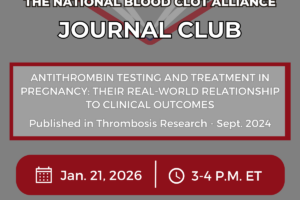WHAT’S IN A NUMBER?
2,000,000, 900,000, 350,000, 600,000 – how many blood clots occur in the US every year? 60,000, 100,000, 300,000 – how many deaths occur each year as a result of blood clots? Based on National Center for Health Statistics data, blood clots would be ranked either third (after cancer), fifth (after chronic lower respiratory disease) or eighth (after flu/pneumonia) leading cause of death by disease. Clearly the numbers are all over the place based on different scientific methodologies from which these numbers are derived or perhaps less than scientific assumptions. Whatever number is used for describing the incidence of blood clots or related mortality, it is clear that DVT/PE is a major public health burden in the US. But it is even more astounding when you consider that the ranking may be as high as third following heart disease and cancer. (Ref: Heitj et al. Blood 2005; 106:267a).
More problematic than the range of morbidity and mortality estimates is that thrombosis/thrombophilia does not appear at all in NCHS top 15 rankings because it is so often associated with other causes of death e.g. cancer. In many risk groups, DVT/PE is a secondary or tertiary concern compared to the focal point of that particular risk group (e.g., cancer patients, medically ill hospital admissions, hip/knee replacement patients). In the aggregate, however, the total number of individuals experiencing DVT/PE is enormous, one of the major public health burdens in the US, whatever the final number turns out to be. But because the total is fragmented it is difficult to sustain a prolonged and sharpened focus on DVT/PE (and for many of the underlying thrombophilias).
CDC Takes the Lead:
Therefore, we need to “connect the dots”, so that data on DVT/PE need to be presented in a fashion to overcome the underlying fragmentation that inadvertently trivializes the important public health problem. The problem was examined at a meeting convened by the America Society of Hematology last August. It is gratifying to see that the Center for Disease Control and Prevention (CDC) National Center for Birth Defects and Developmental Disabilities (NCBDD), Division of Blood Disorders (DBD) has taken the initiative to pursue a national surveillance system for DVT/PE in the US, with a goal towards definitively documenting the incidence of DVT/PE and defining the risk factors in selected patients groups where current data are very limited. Once these groups are identified, evidence-based preventive measures can be effectively promoted to make a substantial impact in reducing the current levels of morbidity and mortality.
The good news is that current and emerging therapeutic agents and other means of preventing DVT/PE are currently (or soon to be) available. The other good news is that once there is better surveillance data, the case for increased funding support for awareness, outreach, and education of patients/families, the general public and healthcare professionals will become far more compelling.
Numbers from the Surgeon General
On September 15, 2008, the landmark “The Surgeon General’s Call to Action (CTA) to Prevent Deep Vein Thrombosis and Pulmonary Embolism” was released. The CTA, providing a much needed public health focus on DVT/PE presented a range of “350,000 to 600,000” DVTs per year with “at least 100,000 deaths”. The CTA underscored the problem of “gaps in application and awareness of evidence-based interventions”. But who is going to pay attention to these “gaps” unless there is an effective and easy way of identifying those who are a greatest risk and would be responsive to preventive intervention(s).
What is NBCA to Do?
NBCA is a patient led and science/data driven organization. What are we to do about the vast array of numbers that are used to represent DVT/PE-related morbidity and mortality? Even though NBCA has used 900,000 DVT/PEs and 300,000 deaths per year, I believe it makes sense for NBCA and all organizations concerned with this issue to speak with a unified voice and to rally around the Surgeon General’s numbers at this time with the understanding that CDC is following a path that will lead to a greater scientific consensus. Recently, in preparing a document seeking funding support for NBCA’s Website, I stated that the Surgeon General recognizes “the public health urgency that 350,000 – 600,000 Americans have blood clots every year leading to at least 100,000 deaths…Recent data out of the Mayo Clinic (J. Heit et al) suggest the number of blood clots may even be higher: closer to 900,000, and nearly 300,000 deaths each year. Perhaps this is the way we should present the data while at the same time, providing as much support as we can for CDC’s surveillance efforts.






